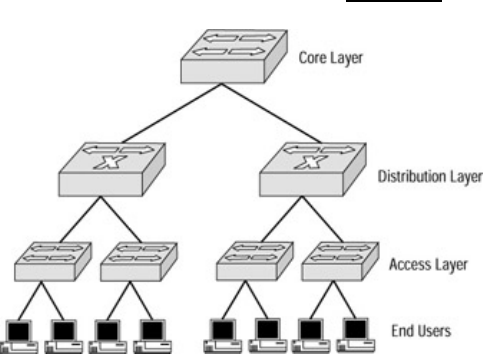
Although the nodes on each port are in their own collision domain, the broadcast domain consists of all of the
ports assigned to a particular VLAN. Therefore, when a broadcast is sent from a node in VLAN 1, all the
devices attached to ports assigned to VLAN 1 will receive that broadcast. The switch segments the users
connected to other ports, thereby preventing data collisions. For this reason, when traffic remains local to each
segment or workgroup, each user has more bandwidth available than if all the nodes are in one segment.
On a physical link between the port on the switch and a workstation in a VLAN with very few nodes, data can
be sent at almost 100 percent of the physical wire speed. The reason? Virtually no data collisions. If the
VLAN contains many nodes, the broadcast domain is larger and more broadcasts must be processed by all
ports on the switch belonging to each VLAN. The number of ports assigned to a VLAN make up the
broadcast domain, which is discussed in the following section.
Broadcast Domains
In switched environments, broadcast domains consist of all the ports or collision domains belonging to a
VLAN. In a flat network topology, your collision domain and your broadcast domain are all the interfaces in
your segment or subnet. If no devices (such as a switch or a router) divide your network, you have only one
broadcast domain. On some switches, the number of broadcast domains or VLANs that can be configured is
almost limitless. VLANs allow a switch to divide the network segment into multiple broadcast domains. Each
port becomes its own collision domain. Figure 1.5 shows an example of a properly switched network.
Figure 1.5: An example of a properly switched network.
Note Switching technology complements routing technology, and each has its place in the network. The value
of routing technology is most noticeable when you get to larger networks that utilize WAN solutions in
the network environment.
Why Upgrade to Switches?
As an administrator, you may not realize when it is time to convert your company to a switched network and
implement VLANs. You may also not be aware of the benefits that can occur from replacing your Layer 2
hubs and bridges with switches, or how the addition of some modules in your switches to implement routing
and filtering ability can help improve your network’s performance.
When your flat topology network starts to slow down due to traffic, collisions, and other bottlenecks, you may
want to investigate the problems. Your first reaction is to find out what types of data are flowing through your
network. If you are in command of the network sniffer or other such device, you may begin to find
over−utilization errors on the sniffer occurring when the Ethernet network utilization reaches above only 40
percent.
Why would this happen at such a low utilization percentage on the network? Peak efficiency on a flat
topology Ethernet network is about 40 percent utilization. Sustained utilization above this level is a strong
indicator that you may want to upgrade the physical network into a switched environment.
When you start to notice that your state−of−the−art Pentiums are performing poorly, many network
administrators don’t realize the situation may be due to the hundreds of other computers on their flat hub and
16


















